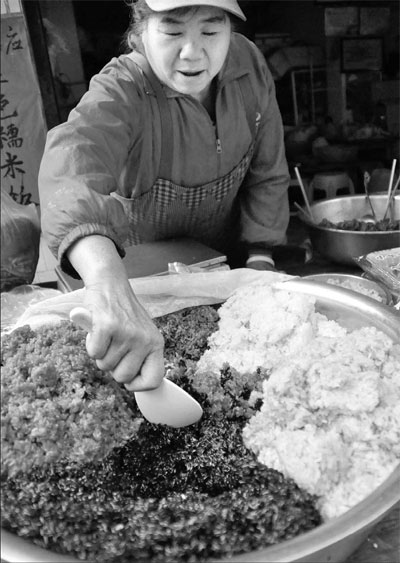Delicacies
Many-splendored rice
Updated: 2011-04-04 07:59
By Huang Zhaohua and Huang Feifei (China Daily)
|
A woman stirs the five-color sticky rice at her food stand in Nanning, the Guangxi Zhuang autonomous region, last week. Lu Bo'an / For China Daily |
Festive dyes make five-color sticky rice a pretty addition to holiday celebrations, Huang Zhaohua and Huang Feifei report.
Nanning
Five-color sticky rice, a traditional festival food for the Zhuang ethnic group in South China, gets its name because the rice is dyed with herbs that yield five colors: black, red, yellow, white and purple.
In traditional Zhuang festivals, such as Sanyuesan (the third day of the third lunar month) and Tomb Sweeping Day, Zhuang people often cook the colorful rice and pray for good fortune and a bumper grain harvest in the year ahead.
The sticky rice must be carefully prepared.
The first step: Choose high-quality glutinous rice. Then color it with maple leaves for black, daylily flowers or cape jasmine seeds for yellow and different magenta plants for red and purple.
Then, steam the rice with lotus leaves to give it a special fragrance.
The colorful sticky rice is mostly used in traditional rituals during the Qingming Festival.
When the plant begins to sprout, Zhuang people like to take some rice seedling, fold it in a pumpkin leaf and put it in a bowl. They would also get some colored sticky rice, roll it into a ball and stick it to a bamboo stick. Both items are then put on the tombs of ancestors as a sacrifice to pray for an abundant harvest.
Around the time of the tomb-sweeping festival, five-color sticky rice is sold on all streets and alleys, and its smell pervades the whole town.
The sticky rice dyed with natural colors also has medical values. For example, the yellow sticky rice is believed to have a heat-clearing function, the red to increase blood and the black to combat rheumatism and strengthen the body.
The art behind
The Zhuang people are extremely careful about the dyeing process when making the colorful rice.
First, the herbs used to make the dye must be snipped into tiny pieces. Next, they are boiled in water for hours to get the dye. The rice is then soaked in the dye overnight to ensure the perfect color.
The black color probably needs the most attention and effort. The maple leaf is the chief material of the black dye. It must be mashed with stem, and then mixed with water.
The best proportion of maple leaves to water is about 1:1.5. The maple leaves must be left in water for a day, then the water will change to yellowish green.
The maple-leaf residue must be removed before the liquid is brought to a boil. The sticky rice is then added and stirred until it changes from light blue to indigo blue, and finally to black. During this process, the water temperature is carefully controlled to be around 50 degrees.
Once the sticky rice has been colored, it should be steamed with lotus leaves for one hour before being served.
Specials

In the swim
Out of every 10 swimsuits in the world, seven are made in China.

Big spenders
Travelers spend more on shopping than food, hotels, other expenses

Rise in super rich
Rising property prices and a fast-growing economy have been the key drivers.
